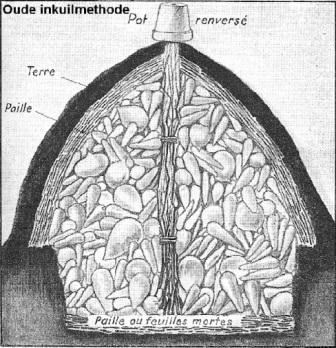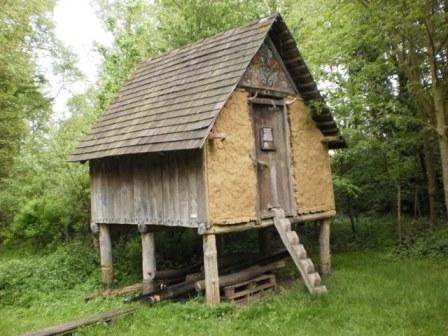Pitting: overwinter fruits in the earth
 Pitting is a somewhat wrong word but a suitable method to store hard tubers, roots and fruits. Nowadays they are kept in huge acclimatized refrigerators.
Pitting is a somewhat wrong word but a suitable method to store hard tubers, roots and fruits. Nowadays they are kept in huge acclimatized refrigerators.
Carrots, (red) beets, apples, potatoes, turnips, celeriac, horseradish, parsnips, radishes, nuts, rutabaga can be stored. Harvesting occurs around October.
When it comes to small quantities, and you have the space (in a shed or basement) you can save it frost-free, dry and dark in boxes. Eventually use any additional protection and cover with dry leaves. Carrots can be kept in sand.
Apples you possibly can pack individually in paper. Good storage types, you can continue to use until May.
Check your stock periodically and remove diseased specimens.
For bigger quantities a pit was used. For a real pit look for a dry spot in the shade. This is to avoid wide temperature fluctuations by winter sun shine. But because the stock has to stay dry, the pits were brought above ground level. Just like silage heaps.
Place a drainage layer of twigs. Cover that with an insulating layer of dry plant debris (moss, straw, reeds...). I often used dry maize stems.
Pile on the fruits. Cover them with a thick layer of dry material of about 25 cm. Try to cover it with reeds, straw and soil in a way that the insulation cannot be blown away and rainwater flows alongside rather than in the ‘pit’. Make every meter (and least one) a ’ chimney’ by shoving a bundle twigs trough the insulation and coatings. This allows the fruit to breathe, and excess moisture can evaporate. If and as long as it freezes hard, remove the twigs and close the chimney.
Around the pit, create a drainage canal (such as around a tent).
Use more insulation and ground deck in colder regions to prevent frost.
Try to open the pit not more than once a month. If you get stock out there then place some in a basement or shed for short term use, so the pit can remain closed again for a long time.
Green apples shed ethylene gas during ripening and that inhibits the germination of potatoes. So put some between the potatoes.
Daffodil bulbs shoo rats and mice and the leaves of marigolds keep pesky insects away. At least for a while. As long as they have alternatives.
To prevent rats and mice gnawing, droppings and nesting to your carrots, potatoes, apples or beets you can make a packing in dense chicken wire around (and under!) the entire stock plus insulating sheath.
Corn and grass for silage by farmers is airtight covered with plastic and then weighed (ground, tires...). This is another preservation method, similar to making sauerkraut. Sealed from air the content sours. This food is processed, not just kept.
If you fetch beets for the animals, clean them thoroughly before feeding: scraping, brushing, washing. Do you like to have earth in your mouth?
Also frozen fodder beets are still usable, as long as they do not thaw. Thawed they have to be used very soon!
Celeriac can also de stored in a container with soil in a frost-free basement.
Horseradish can be long preserved (approx. 1 year).
For cabbage get rid of any loose leaves, leaving only the closed, solid head with the stem and roots (without soil). Hang them dark and frost free with the roots upwards. If you cut the cabbage heads it can sprouts again and produce still flowers and seed. You can hang them in a bag to harvest the seed for use.
If you do not have time to pick peas or beans and dry them, you can also grub and hang the bunches in the same way. (The dried leaves in the winter also can be used as animal feed.)
Hang your corn cobs peeled dry and airy in a net where mice and birds cannot reach them.
Also nuts (beechnuts, hazelnuts, walnuts, chestnuts (sweet!)) and sunflower seeds store easily. Nutcrackers in rod shape sometimes crush the inner nuts. There is a better model with the pivot point at the top, and the jaws as semicircular conical shells. Depending on the thickness of the nut you slide them more or less deep. They will never be completely crushed in the jaws.You can also crack nuts on a firm, empty sparkling wine bottle with a hammer.
In ancient settlements and huts often pits are found which researchers assume that they were used to preserve food. Experimental archaeologists tried to keep nuts this way. It seems like a good idea, since squirrels do that. Directly buried or in a basket, the results were disappointing. Sewn into a smoked skin with charcoal above and below 90% of the stock stayed good for 4 months.
Nuts are mold sensitive. And they should fall in dark and damp ground to germinate next year. So maybe not the ideal repository.
Airy and dry, not too thick on each other (2 layers), crate, I have no problem to keep them well until deep into the spring.
Onions, shallots and garlic can be braid together with the dried leaves and hung in strands or bundles.
 Our ancestors, the Celts, stored their grain and stock for around the beginning of our era in underground, bell-shaped voids. (Diameter and depth were mostly similar, rarely more than 3 meters. The opening narrow.)The grains against the damp ground germinated, so they absorb oxygen and gave off carbon dioxide. This makes them for other grains inside a natural shield against decay. The grains remained months, even several seasons suitable for consumption. (Sprouted grains can be eaten or used for malt.) In sandy soil, large earthenware jars (165 liters) or straightened webs of twigs were used.
Our ancestors, the Celts, stored their grain and stock for around the beginning of our era in underground, bell-shaped voids. (Diameter and depth were mostly similar, rarely more than 3 meters. The opening narrow.)The grains against the damp ground germinated, so they absorb oxygen and gave off carbon dioxide. This makes them for other grains inside a natural shield against decay. The grains remained months, even several seasons suitable for consumption. (Sprouted grains can be eaten or used for malt.) In sandy soil, large earthenware jars (165 liters) or straightened webs of twigs were used.
A ‘spieker’ or granary (spica is Latin for grain, Spicarium = granary) is a building for grain storage. There still exist several, sometimes from the time when farmers paid the lease with grain. The Old Teutons also built them already, usually on four (or more) poles, high above the ground, to repel rodents and moisture.
‘Onion : the only food that excites tears befor being consumed.’(Henry Beard)
